
Reveal Mobile


A Deeper Dive into Reveal Mobile
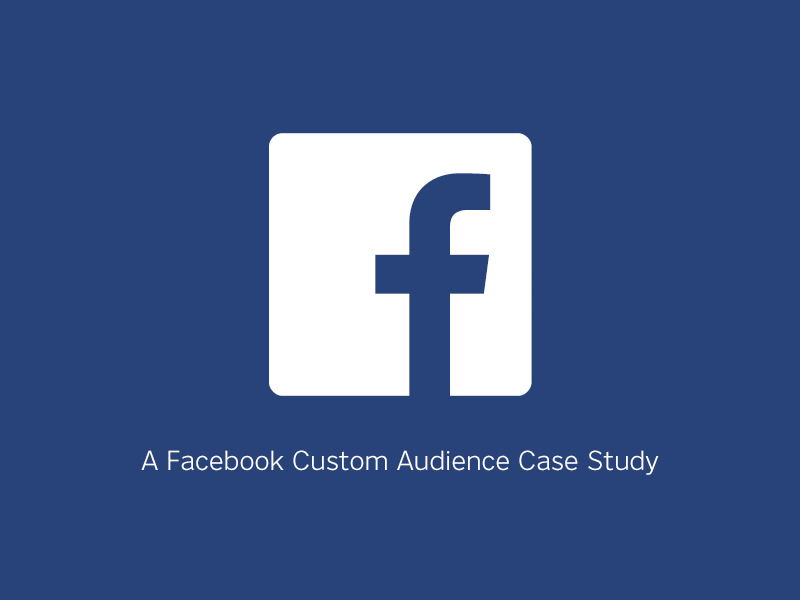
A Facebook Custom Audience Case Study
When Graham Media’s digital sales team at WSLS partnered with a mattress manufacturer, they built out a thoughtful and strategic marketing plan across many different platforms, but they were stuck on one component. How could they find consumers that were actively shopping for a mattress at retail locations, and then reach those users online where they frequent most: Facebook. By leveraging Reveal Mobile’s Visit platform, they were not only able to find this audience, but the campaign results exceeded their expectations.
Challenges to Overcome
The digital sales team at WSLS, a Roanoke, VA based television station and Graham Media company, worked diligently to understand the client’s needs. The end goal was to sell more mattresses, but as a small business, brand awareness and thought leadership were at the forefront of the marketing campaign. They had a great story tell, and wanted to ensure that story reached the most relevant audience, ensuring the best return on ad spend. The campaign faced the challenges of educating the consumer, building brand awareness, and finding an audience that is actually in the market for mattresses. Not only did they want to retarget visitors to their own retail locations, but also audiences seen at competitive locations.
While there are services that allow this type of targeting on desktop websites through cookie tracking, they turned to Reveal Mobile to help them find this audience across social media and mobile apps.
Building a Solution Together
The mattress manufacturer’s main selling point is the upper-tier quality of the mattress and lack of toxic chemicals. Everyone involved understood the importance of creativity in any ad campaign. As a result, they would showcase their brand and emphasize the quality of their product through educational and entertaining video segments. These short videos highlighted easy ways to become educated about the mattress buying process, and what buyers should look for when making such a long-term purchase.
WSLS then turned to Reveal Mobile to help find their target audience on social media. In order to find that target audience, they used the Social Direct product to build location-based audiences that visited not only their own locations, but also locations of their competitors in the target market. By identifying an audience of consumers actively visiting mattress stores, they built a highly relevant target segment.
Social Direct makes these audiences portable, allowing any advertiser, agency, or sales team the ability to upload the data as a custom audience to Facebook, Instagram, Twitter, or Snapchat. The ad operations team can then continue to build the ad campaign as they normally would, using the custom audience delivered from Social Direct.
The end goal was to sell more mattresses, and the campaign exceeded expectations. The manufacturer was able to attribute 4 additional mattress sales to the campaign .
The campaign engagement saw a 160x improvement over the industry average desktop advertising click-through rate (CTR). This campaign achieved a 3.3% CTR compared to the standard 0.02%, a 160x improvement. The 3.3% CTR also bested the typical social media CTR of 0.90% by 266%.
Most importantly for the sales team, WSLS was able to increase the value of their offering and thought-leadership with the client. By providing a targeted audience, they commanded a premium on their pricing.
Testimonials
“I absolutely love the Social Direct product. It gives us a unique position in the market and and allows us to bring innovative and high-performing solutions to our customers.” – Ashlee Chambers, Digital Sales Manager
“Having a solution that allows us to compete with Facebook, Google and even now Amazon for local ad spend is critical for our digital sales team. We have to bring new ideas and capabilities, and Reveal Mobile help us stay relevant and deliver the results our clients demand. – Catherine Badalamente, VP Digital Media
Download the PDF of this case study
Improve campaign performance and win more business .

Facebook (Meta) Custom Audiences - Increase Your Conversion Rate

For today’s companies, Meta’s platforms offer some incredibly valuable opportunities to connect with more customers and drive greater revenue. Platforms like Facebook and Instagram are packed with features that advertisers can harness, and one of the most interesting examples here is that of Custom Audiences.
In this article, we’ll take a look at why Custom Audiences are so useful, if they still work in the wake of new privacy changes from Apple and others, the different ways to use them, and how to get started with your own, how to create custom audience on facebook. We’ll also share some examples of companies who have successfully used Custom Audiences to grow their brands.

Let’s get started.
What is a Facebook Custom Audience?
So what exactly is a Facebook Custom Audience, and why should you care?
In simple terms, it’s a highly-targeted specific audience segment, created by drawing on the customer data you’ve collected from people who have engaged with your business in some way in the past.
By combining information like previous app activity, interactions with your business, website activity, and purchase history, it’s possible to create a highly defined group of people for future targeting.
The beauty of Custom Audiences is that they focus on people who are already familiar with your brand or people similar to those. This means they already have some awareness of who you are, they’re more likely to be interested in your products, and you already know certain things about them.
This makes your Custom Audience members a much better target for engagement and conversion compared to people who have no idea about your brand. You can create specific marketing campaigns and activities for these people, improving your chances of success.
Why should you use Custom Audiences?

What are the concrete benefits of building these Custom Audiences who have a history with your brand? Let’s take a look at some of the key advantages here.
- Better targeting and messaging
- If you already know something about who you’re talking to, targeting and messaging becomes easier. You can target your ads more precisely and ensure your messaging is as relevant as possible to the target audience, driving higher conversion rates.
- Increased engagement
- People are more likely to engage with a brand they already know. Custom Audiences can lead to higher engagement — more clicks, likes, and shares — from the people you target.
- Cost-effective
- Custom Audiences allow you to be more precise and deliberate in your advertising. This allows you to optimize your ad spend, focusing your precious budget on people who are more likely to convert and improving your ROI.
- More opportunities for personalization
- Personalization is much easier when you know something about who you’re talking to. Custom Audiences make it much easier to deliver personalized messaging, offers, and ads to your customers, helping build more solid relationships.
iOS14.5 updates and Custom Audiences
Apple’s iOS14.5 update was a big moment for marketers who rely on user data.
The update turned off the Identifier for Advertisers (IDFA) by default. In other words, users now have to actively opt into sharing their data with companies, as opposed to this being the default option.
Unfortunately for many advertisers, only about 25% of users have decided to opt in. This makes it much easier to track users across apps and collect data that can be used in marketing — including when it comes to building Custom Audiences.
So what’s the solution? The good news is, things aren’t hopeless, and there are still several options available when it comes to building Custom Audiences. Here are some best practices:
- Make the most of first-party and zero-party data.
- The information your prospects share directly with you, with their explicit content, is a powerful resource. Not only is it not affected by the latest iOS update, but first-party and zero-party data is also typically more reliable and accurate than other types of data.
- Gravitate towards broader audiences.
- Larger Custom Audiences tend to work better than narrower ones in the post-iOS14.5 world.
- Rely less on website-based audiences
- Which are less useful after the iOS update, and focus more on the audiences you build in-app on Facebook and Instagram.

The digital marketing landscape is changing all the time, and shifts like this one are simply part of what advertisers have to deal with. It’s all about getting creative and working with the tools you have available.
How to create Custom Audiences on Facebook
There are two ways to create Custom Audiences on Facebook. You can choose to do it yourself manually or use Driftrock for an automated option.
Setting up Custom Audiences manually is fairly straightforward within Facebook’s tools like Ads Manager and Business Manager. Here’s how.
How to create Custom Audiences
There are three main types of Custom Audiences, based on where you’ll collect your data. The three options are customer list, website, and app. Here’s how to set up Custom Audiences for each of these three.
The first step for all of these is to open the Facebook Audiences page in Ads Manager and select the option to Create a Custom Audience.
Create a Custom Audience from a customer list
- Put together a customer list and save it in a CSV or TXT format
- Select “Customer list” as a Custom Audience Source to let Facebook know where your data is coming from
- Import your list by uploading the CSV file or TXT file, and give it a name
- Review your list to make sure there are no errors, then hit Upload & Create
Create a mobile app Custom Audience
- Register your app with Facebook and then set up the SDK to allow you to track your users within the app
- Select “App Activity” as your Custom Audience Source
- From the Source dropdown, select “App”
- In the App Events section, decide how you will qualify people for this Custom Audience. For example, you could target everyone who opened your app, only those who made a purchase, or some other specific app event.
- Give your Custom Audience a name to make it easier to identify and track
- Hit Create Audience, and Facebook will do the rest
Create a Custom Audience from website visitors
- Install Meta Pixel
- Choose “Website” as a Custom Audience Source
- Set the rules for your website Custom Audience. This is where you define who you will target, for example, all website visitors, only those who visited specific pages, only those who stayed for a certain length of time, or a range of other options depending on your website traffic.
- Give your website Custom Audience a name. This will make it easier to identify and track in the future.
The downside to this manual approach is that your Custom Audiences won’t update automatically. This means you’ll need to manually upload new customer data as you acquire it — which becomes extremely time-consuming.

Create a Custom Audience using Driftrock automatically
Working with Driftrock, you can do things differently. Driftrock allows you to connect your Custom Audiences to your CRM and automatically sync customer data to your audiences on an ongoing basis, with no need to do this manually.
Driftrock Audiences is designed to help you manage and convert your leads by continuously syncing customer segments with custom audiences on Facebook, Google , and LinkedIn .
This enables you to target, exclude, and create lookalikes for your marketing campaigns.
The use of automated audiences offers a secure and scalable approach. It will help you protect privacy and stay compliant by removing records if people unsubscribe from marketing communications.
Ready to set up Driftrock Audiences? Here's how:
- Sign in or Login to Driftrock
- Choose 'audiences' (audience nurturing) from the navigation bar on the left.
- Hit the 'setup new sync' button
- Fill out the necessary details

- Assign a name to your audience.
- Select the source (CRM, Database, etc.)
- Determine the customer segment.
- Decide the destination for syncing the data (Facebook, LinkedIn, or Google).
- Set the data syncing frequency (3 hours, daily, or weekly). We suggest a weekly sync for Lookalikes and every 3 hours for exclusions and targeting.
- Click 'save!'
- In about 10 minutes or so (depending on the size of your audience), you'll be able to start utilising your audience.
Different ways to use Custom Audiences
Once you’ve set up your Custom Audiences, it’s time to get familiar with the various features and tools inside that you can use to improve your advertising and connect better with your customers.
Let’s take a look at some of the key concepts to understand here.
Retargeting
Retargeting involves using Custom Audiences to target people who have already interacted with your brand with new messaging and ads. Many of these users will be at a stage where they’re considering buying from you but aren’t quite ready to take that next step — here, a retargeting ad can make all the difference. Retargeting also reminds users of who you are and can strengthen their relationship with you. This includes website visitors and engagement audiences.
Website Visitors
People who visit your website are excellent candidates to be included in a Custom Audience since they likely showed up for a reason and are already aware of who you are. By targeting these people and engaging with them, you may have much more success than if you simply targeted a random selection of people.
Engagement Audiences
Building Custom Audiences based on engagement means targeting people who have interacted with your brand’s content in the past. That means things like your social media posts, ads, and other content you’ve shared on those platforms.
Lookalike Audiences
A lookalike audience is a way of targeting people who share similar characteristics, behaviours, and attributes with your existing customers. This can be extremely useful — for example, if you have a campaign that’s working really well with one existing audience, you can use a lookalike audience to expand the pool of potential targets, knowing that it’s likely to be successful. You can also use a list of your existing customers or qualified leads.
Excluding Audiences
Not all of your Custom Audiences will be made up of people you want to target. An “Excluding Audience” is like the inverse of a normal Custom Audience — it’s composed of people you specifically don’t want to target. You might want to avoid targeting existing customers, unresponsive users, or segments who just won’t respond well to a certain campaign — Excluding Audiences are a great way to do this.
Lead Nurturing
Lead nurturing, similar to retargeting — where you take leads who have previously expressed interest in your brand and guide them gradually through the sales funnel with content and offers you think they’ll like — works extremely well with Custom Audiences.
How to use Facebook Custom Audiences: some ideas
Custom Audiences have a ton of potential when it comes to connecting with your audience and growing your brand. Here are some ideas for how to use Custom Audiences in different ways.
Customer loyalty programs
Create a Custom Audience made up of loyal customers who regularly engage with your business and have used your services for a long time. You can then offer these customers rewards like discounts and early access to new products, helping build stronger connections with your most valuable customers.
Abandoned cart recovery
Using your CRM, identify customers who have abandoned their shopping carts on your website before making a purchase. Then, create a Custom Audience of these users and target them with ads, giving reminders and offering incentives if they return to complete the purchase. This is a great way to drive conversion rates from prospects who are already halfway there.
Competitor targeting
Build Custom Audiences based on the customer bases of your competitors. You can then target these audiences with marketing campaigns highlighting your unique selling points and drawing them to your brand.
Event promotion
If you’re running an event like a conference or webinar, create a Custom Audience composed of people who have previously attended similar events or shown an interest in the topic at hand, then use this to promote your event and drive higher attendance.
Subscription renewal and upselling
Create a Custom Audience made up of people whose subscription or membership is about to expire, then deliver targeted ads to them to encourage them to renew. You can also offer discounts and personalized offers to sweeten the deal or upsell to higher-tier plans.

Custom Audiences case studies
Now let’s take a look at some examples of companies that saw impressive results when they used Custom Audiences. The great thing here is that Custom Audiences can work well across a wide range of industries and for different types of goals.
The fashion brand ChicMe used Custom Audiences combined with some other Facebook advertising tools to connect with its target audience, driving an 82% lower cost per conversion, a 3.7X higher return on ad spend, 13% higher clickthrough rates, and 14% higher add-to-cart completion.

ChicMe is a fashion e-commerce company, offering clothing, jewellery, shoes, bags, and more to women around the world. Their goal was to improve ad performance and drive more sales in an increasingly challenging data privacy environment.
Previously ChicMe had been using broad audience targeting, which was becoming difficult in the face of new regulations. They created lookalike audiences by drawing on their own first-party data about existing customers and then created a new Facebook Custom audience based on the highest spenders.
Australian streaming service Stan used Custom Audiences as part of a brand awareness campaign focused on Augmented Reality ads on Facebook and Instagram. They saw a 15-point lift in standard ad recall, and 20,000 people launched the Augmented Reality effect, with 44 hours total time spent on the AR.
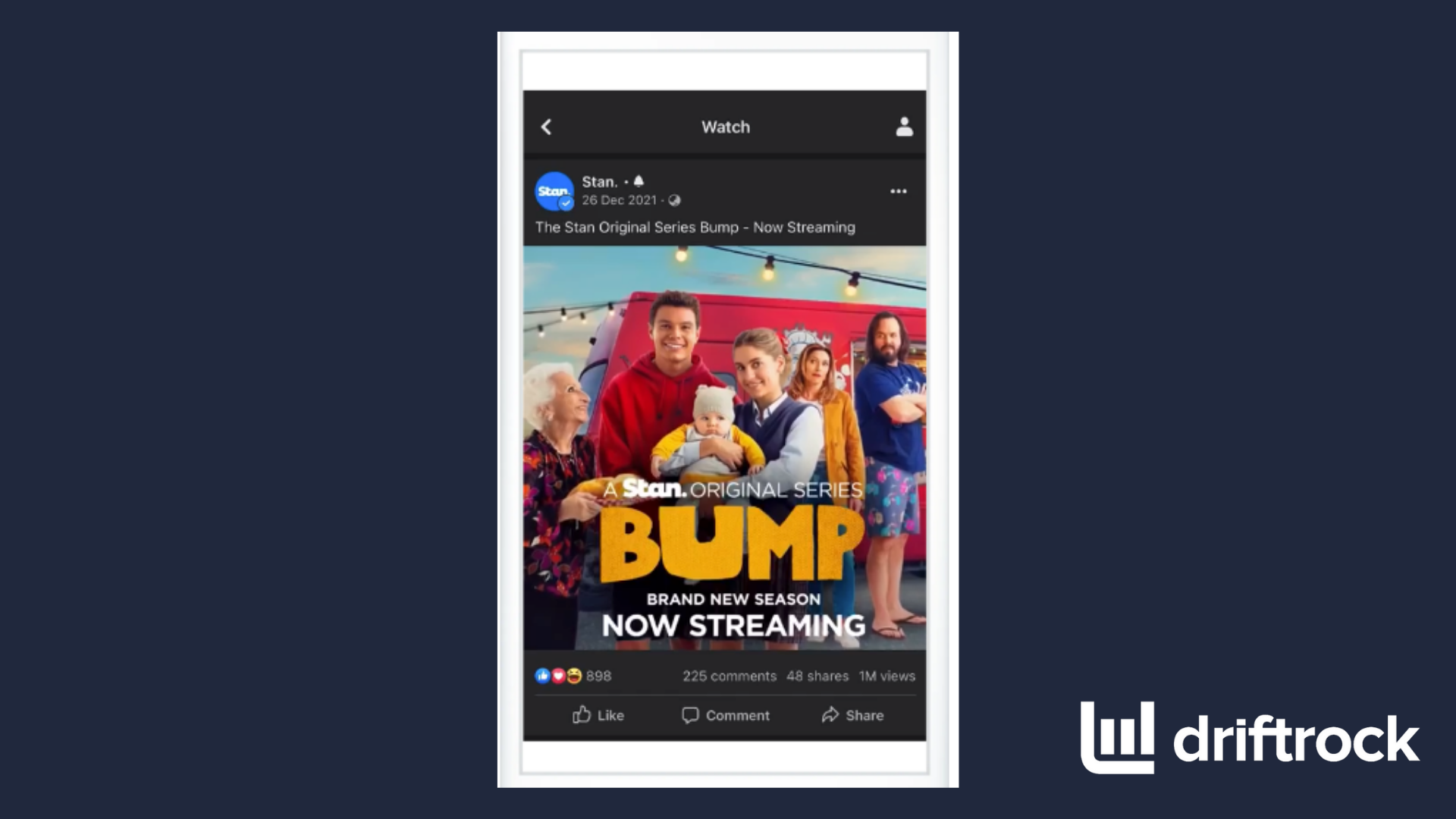
Stan offers unlimited access to movies, TV shows, and live sports to Australian viewers, including its own roster of original productions, many of which are critically acclaimed. They wanted to lean into emerging technology to gain new subscribers and retain their current customers
Stan decided to use augmented reality (AR) ads on Facebook and Instagram to promote a new season of Bump (its highly successful show). The Stan team created sophisticated AR ads that would provide users with an immersive and interactive experience focused on Bump.
They showed these ads to a Custom Audience of existing Bump fans on Facebook and Instagram to drive more targeted engagement.
Loop Club and Muir Way
Growth marketing agency Loop Club built a full-funnel acquisition strategy with Meta to promote their Elevation Maps. After their initial success with their acquisition efforts, Loop Club then used Custom Audiences for remarketing. Overall, they made $834,000 in Meta-attributed revenue across the whole campaign, achieved 426% attributed revenue growth year-on-year, and drove $498,000 of attributed revenue in Q4 2020.

Loop Club scaled purpose-driven Shopify e-commerce brands. They worked with mapmaker Muir Way to find a broader audience for Muir Way’s series of Elevation Maps — growing revenue without significantly increasing cost per new customer. Loop Club ran a campaign to find a broader audience for Muir Way’s maps and successfully used Dynamic Ads to prospect and get a solid return on ad spend.
Following their initial success, Loop Club then moved to a remarketing strategy. They built a video ad creative highlighting the Elevation Map products and showed this to Custom Audiences of people that visited the Muir Way website.
Tap into Custom Audiences with Driftrock
Custom Audiences can be an incredibly powerful tool for today’s marketers. By building audiences composed of people you already have some connection with, it’s possible to change the way you build relationships and conduct marketing activities — allowing you to drive more return on investment, build stronger bonds with your customers, and optimize your ad spend.
At Driftrock, we can help you harness the power of Custom Audiences. We offer automated audience sync with Meta’s platforms like Facebook and Instagram, along with LinkedIn and Google, so you can create lookalike, exclusion, and retargeting lists.
We ensure full compliance with GDPR and all other relevant data protection laws, and we can guide you through every step of the process to set up your Custom Audiences safely and effectively.
Get in touch with us or Sign Up today to learn more and get started.
We help make marketing something you want to see.

Terms of Service Privacy Policy Data Protection
How to Use Facebook Custom Audiences: A Step-by-Step Guide
A Facebook Custom Audience offers some of the best ad targeting available. Follow this step-by-step guide to quickly set up your own Custom Audiences.

Table of Contents
With 2.82 billion daily active users , Facebook has a large and varied audience. Not everyone fits your customer persona, and that’s why you need to use Facebook Custom Audiences.
Because it’s really sad when a good ad is viewed by the wrong audience!
Never again. Instead, create laser-targeted ads to reach the Facebook users who are most likely to be interested in your business. This allows you to minimize your ad spend and maximize ROI .
Keep reading for a step-by-step guide on how to find the exact audience looking for your product or service.
Bonus : Download a free guide that shows you how to save time and money on your Facebook ads. Find out how to reach the right customers, lower your cost-per-click, and more.
What is a Facebook Custom Audience?
Facebook Custom Audiences are highly defined groups of people who already have a relationship with your business. These groups likely include past customers and people who have visited your website or installed your app.
Even better, Customer Audiences can create lookalike audience s – new potential fans, followers, and customers who share key characteristics of your existing audience.
Basically, it offers some of the best ad targeting available.
But not everyone is a fan of data sharing. Some argue it’s an invasion of data privacy.
That’s why Apple changed its policy with the iOS 14.5 update to turn off the Identifier for Advertisers (IDFA) by default.
The IDFA tracked user behavior within apps – making it easier to create highly-targeted ads.
With the new Apple update, users are prompted to opt-in or opt-out of data sharing for each app they use.
So far only 25% of users have opted in to data sharing. Without the default IDFA setting, advertisers and app developers are drastically limited in tracking user activity.
How does it affect Facebook Custom Audiences?
You may notice results decrease, and you may want to consider alternative strategies if that’s the case for you.
Facebook recommends using a broad audience or targeting expansion to meet your campaign goals. You can also find more detailed guidance here .
Regardless, Facebook Custom Audiences can still help you reach your ideal customers, and there are plenty of ways to connect with them.
Types of Custom Audiences
There are actually several ways to build a Custom Audience. Let’s review the types and sources for creating a Facebook Custom Audience.
Custom Audiences from customer lists
Customer lists are an audience who have already shown an interest in your business or product. But the source doesn’t come from Facebook engagement or Meta Pixel.
Instead, you tell Facebook “identifiers” you’ve collected from your audience. Examples include the email address of a newsletter subscriber or past customers who have shared their phone numbers with you.
These are people who have engaged with your business in some way, but Facebook has no way to identify them until you upload a customer list.
Keep in mind that there are a lot of data privacy rules around customer lists . Here are some aspects to consider:
- You can only upload data from customers who have consented to their information being used for marketing purposes
- You can’t use a purchased customer list or data you’ve gathered from other websites
- If someone opts out of your email list, you need to remove them from your Custom Audience too
- Check Facebook’s Terms of Service to ensure compliance
Custom Audiences from your website
Once you install the Meta Pixel on your website, it can match your website visitors to their Facebook profiles.
You can use this information to create Custom Audiences that target:
- All website visitors
- People who have visited a specific product page or product category.
- Recent website visitors by choosing a timeframe for how far back you want to go
If you haven’t installed the Meta Pixel yet, you’re missing out on this rich source of data. Check out our full guide to using the Meta Pixel to get it set up on your site.
Custom Audiences from your mobile app
Want to get to know the people using your app? There’s a Custom Audience for that.
All you need to do is register your app and set up the Meta SDK and log app events on the Meta for developers site .
(If that sounds too techy for you, talk to your app developer to help you out with these preliminary steps.)
This type of Custom Audience can be a great basis for app engagement campaigns. Some targets include:
- People who have downloaded your app but may not be using it yet
- People who have made in-app purchases
- People who have achieved a certain level in your game
Engagement Custom Audiences
An Engagement Custom Audience is made up of people who have interacted with your content across Meta technologies like Facebook or Instagram.
These people have done specific actions like:
- Viewed a video
- Followed a Facebook page
- Clicked on an ad
- Responded to an event as “Interested”
While Facebook keeps track of these actions, you can also create a setting to refresh the audience, say, every 30 days.
This means only people who have engaged with your content in the past 30 days will be part of your Engagement Custom Audience. It helps ensure you’re still relevant to the people viewing your ads.
How to create custom audiences in Facebook
For all Custom Audience types, you’ll start by opening your Facebook audiences page in Ads Manager and clicking “Create a Custom Audience” .
(If you’ve created an ad before, you’ll see a dropdown menu instead of a button.)
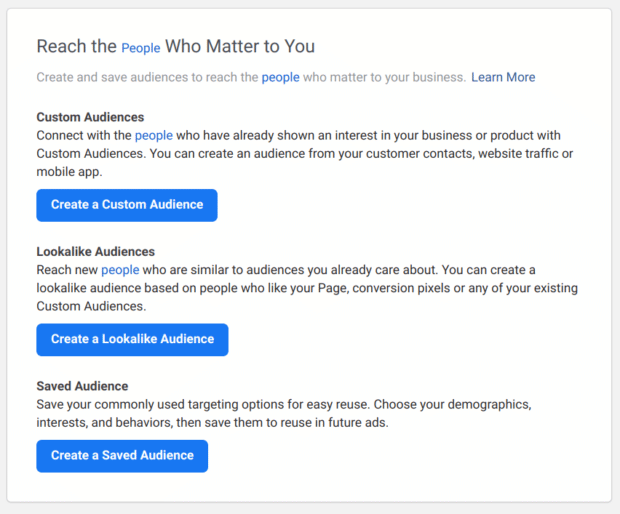
From here, the process depends on what kind of Custom Audience you want to create.
How to create a Facebook custom audience from a customer list
1. Prepare a customer list in advance.
You provide Facebook the information on your customers, so you’ll need to create a CSV or TXT file of “identifiers” (such as an email address) to help it match your information to Facebook profiles.
Luckily, Facebook has a guide on how to format your customer list to get the best matches.
2. Choose a Custom Audience Source.
You’ll be presented with a variety of options on where the source of your information comes from.
Select “Customer list” and move on to the next step.

3. Import customer list.
If you prepared a CSV or TXT file, then you can upload it here.
You’ll also name your Custom Audience at this point. If you’re using MailChimp, you have the option to import it directly from there.
4. Review your customer list.
Facebook will let you know if there are any errors on your list. This gives you a second chance to ensure your list is correctly mapped.
Once you’ve reviewed your list, you can tap “Upload & Create” .
Facebook will let you know when your Custom Audience is ready to use for ad campaigns or to create lookalike audiences.
How to create a Facebook custom audience from website visitors
1. Install Meta Pixel or ensure it’s active.
Your website visitors can only turn into a Custom Audience if Meta Pixel is installed on your website.
If you need help, check out our guide on using Meta Pixel on your website .
Select “Website” and move on to the next step.

3. Set rules.
This is the fun part. You’ll choose the source, events, retention period, and inclusive/exclusive rules.
Some of the rules you can create or select include:
- Target all website visitors
- Target people who visited specific pages or websites
- Target visitors based on time spent on your website
- Timeframe of how long people will stay in the custom audience after their last website visit
- Include a different set of visitors
- Exclude a specific set of visitors

4. Name and describe the Custom Audience.
To make it easier to track all of the Custom Audiences you’re making, give clear names to each one.
You can write a quick description for further clarification if needed.
5. Select “Create audience”.
Ta-Da! Facebook will prepare your Custom Audience based on your website traffic and designated rules.
How to create a mobile app Custom Audience
1. Register your app and set up the SDK.
Before you begin, you need to set the stage. You’ll need to follow these steps to register your app with Facebook.
And then you can set up the SDK to track “App events” or specific actions your users take on your mobile app. You may need a developer’s help for this step.
Select “App activity” and move on to the next step.

3. Select App from the Source dropdown.
4. Select app events for Custom Audience.
From the dropdown menu, choose which actions or “app events” will qualify someone for this Custom Audience.
Some examples include:
- Opened your app
- Achieved a level
- Added their payment information
- Made an in-app purchase
You can also choose to include or exclude people based on their app events.
5. Refine specific details.
You can get hyper-specific in this step. For example, maybe you don’t want to target everyone who made an in-app purchase.
You might want to focus on people who spent a specific amount. You can set up those rules here.
6. Name and describe the Custom Audience.
7. Select “Create audience”.
You’re finished! Facebook will do the rest of the work to create your Custom Audience based on your specifications.
It can take up to an hour to collect all past users who meet your criteria.
How to create an engagement Custom Audience
1. Choose a Custom Audience Source.
You’ll be presented with a variety of options from Meta Sources.
For this example, we’re selecting “Facebook Page”. Pick what Meta Source you are using and move on to the next step.

2. Set rules.
Depending on your Meta Source, you’ll choose events, define retention periods, and create inclusion/exclusion rules.
For a Facebook page, you can choose events like:
- Liking or following your page
- Engaging with your page
- Viewing your page
- Commenting or liking an ad
- Clicking a call-to-action button on an ad
- Sending a message to your page
- Saving a post
You will also select how long people will stay in this Custom Audience after triggering the event, and you can decide if any people should be included or excluded from this Custom Audience.

3. Name and describe the Custom Audience.
As before, write a quick description for further clarification if needed.
4. Select “Create audience”.
Once you’re ready, Facebook will create your Custom Audience based on your specifications. Then you can use it for your next ad campaign.
How to use your Facebook Custom Audiences
There’s a lot of technical detail in building the right ad campaign. But you also need to think strategically about how to use Facebook Custom Audiences to maximize your ad spend.
Here are some ideas:
Retargeting campaigns
Retargeting is an effective way to remind past visitors about businesses they’re interested in and encourage them to take action like making a purchase.
McBride Sisters Collection, a Black-owned wine company, used retargeting to rekindle consideration from lapsed customers.
The customers were pulled from the company’s customer relationship management (CRM) database and then were delivered dynamic ads on its wine collection.
The overall campaign saw a 58% lift in purchases .

Engage repeat customers
Existing customers already know and trust your brand – so marketing to them can produce much higher conversion rates than trying to reach people who have not bought from you before.
Turning casual customers into repeat customers is a cost-effective way to grow your sales.
Clinique US used Custom Audiences to show its dynamic ads to people who had previously engaged with the beauty brand.
The company also chose to create a lookalike audience that shared characteristics with past product purchasers and repeat customers.
The overall ad campaign saw a 5.2 point lift in action intent with combined people- and product-focused ads.

Increase app engagement
If you’re running an ad to increase app engagement, there’s no point in showing the ad to people who have yet to download your app.
With a Custom Audience of people who already have your app downloaded, you can target your ad effectively, helping you to get the maximum impact for your budget.
Grow your Facebook following
Brand awareness builds the foundation of your marketing funnel. Creating targeted ads is a crucial aspect of making people aware and interested in your product or business.
Use a Facebook ad with a Custom Audience based on website visitors or a customer list to promote your Facebook Page to this highly targeted group.
Just make sure to exclude people who have already liked your Page, so you don’t pay to reach existing Facebook fans.
Use lookalike audiences
Custom Audiences are used to make lookalike audiences – a group of people who share similar characteristics to your Custom Audience.
In theory, a lookalike audience is more likely to be interested in the products and services you offer compared to a broad audience.
Liquid I.V., an electrolyte drink mix, used Custom Audiences for people who had purchased in the past, added an item to their shopping cart, or engaged on social media.
Liquid I.V. also took its customer list to create lookalike audiences based on characteristics shared with online product purchasers.
The overall ad campaign led to a 19 point lift in ad recall .
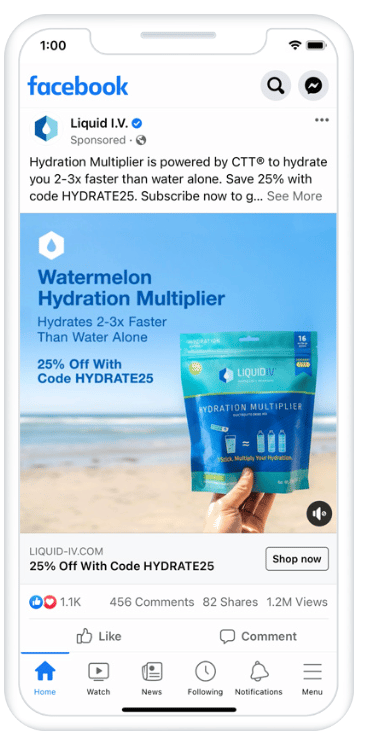
How to grow your Custom Audience
There’s value in expanding your Custom Audiences since they put your ad in front of more targeted potential fans, followers, and customers.
Here are some ways to expand your list.
Use Facebook Ad types effectively
To grow your Custom Audience, you need people to engage with your ads, social media profiles, or website.
When it comes to Facebook ads , you should ensure you have a Custom Audience prepared to track the people who engage with your ads.
This automates the process of ensuring no potential follower goes unnoticed, and you can create retargeting ads for them.
Another way to grow your Custom Audience is to focus on the Awareness objective. This helps you reach a larger number of people within your target group.
Test and tweak your ads for maximum conversion
Sometimes you need to experiment with your ads to find what resonates with people the most. The more effective your ad, the more quickly you will build your Custom Audience.
We’ve got a whole blog post on how to test and refine your social media ads , but here are some key elements to test:
- Link preview text
- Call to action
- Image or video
Use Facebook Audience Insights
Analytics are great and all, but you need actionable insights into your audience. Facebook Audience Insights can provide you with valuable information about the demographics of your Custom Audiences. You can take those insights and use them to target new audiences. Ideally, the new audience will engage with your ads or content and then become part of your Engagement Custom Audience.
Need some extra Facebook ad inspiration? We got you. Here are 22 Facebook ad examples to get your creative juices flowing.
Manage your Facebook presence alongside your other social media channels using Hootsuite. From a single dashboard, you can schedule posts, share video, engage your audience, and measure the impact of your efforts. Try it free today.
Get Started
Become a better social marketer.
Get expert social media advice delivered straight to your inbox.
Sara J. Nguyen is a freelance writer specializing in cybersecurity and marketing. Her educational background in public relations helps her work closely with companies to provide informative and engaging content for their audience. When she's not writing, you can find her planning her next international trip
Related Articles

11 of the Best Instagram Editing Apps for 2024
Want to keep up with the latest visual trends on Instagram? These Instagram editing apps will help you make your content stand out.


250+ Free Social Media Templates to Save Your Team HOURS
These free social media templates will save you a ton of time and effort, from creating content, to publishing posts and measuring results.

How to Use LinkedIn Hashtags in 2024 [+ FREE TOOL]
Hashtags that work on other sites may not apply on LinkedIn. Here’s how to build a LinkedIn hashtag strategy that will help you grow.

Social Media Style Guide: Template, Examples & Tips for 2024
Learn how to build a consistent brand voice on social media with a custom social media style guide (free template included)!


- ConnectAudience
- ConnectAutomate
- ConnectExplore
- ConnectLeads
- ConnectRetarget
- ConnectVideo
- ConnectSuite
- Integrations
The Ultimate List of Facebook Ads Case Studies (+ 38 lessons you can’t ignore)
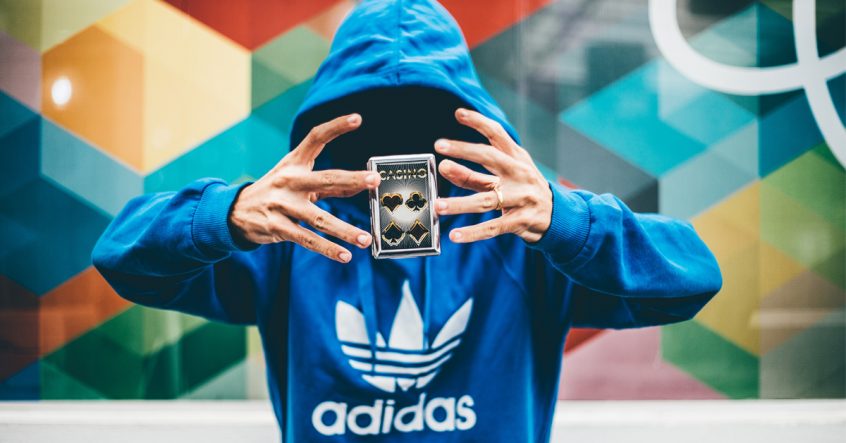
by: 6 Comments
Without a doubt, Facebook is THE place to be to build audiences and generate revenue.
You know it, I know it… Every single marketer knows it.
But with it’s decreasing organic reach, you’ll need to rely on Facebook Ads more than ever.
That means your money is on the line, which is why you’ll want to know what REALLY works and what doesn’t work before you even get started.
So, to bust all the myths and speculations, we’ve been analyzing 13 Facebook Ads case studies from various well-known experts.
From campaigns spending $1/day to millions a year. Campaigns focused on bringing in hundreds of thousands in revenue as well as bringing in low-cost leads.
You’ll get to see it all in the following 13 Facebook Ads case-studies.

Case Study # 1 – What Noah Kagan Learned Spending $2 Million on Facebook Ads
This is the case study and key insights from Noah Kogan who has spent millions on Facebook Ads so far.
The advice and lessons learned from this case study will be far more insightful than people that have to spend some hundred or thousands of dollar on Facebook Ads.
Noah Kagan of AppSumo and SumoMe shared his experience spending $2 million on Facebook Ads across his different products.
Apart from promoting his key products ( AppSumo and SumoMe ), he showed how he earned $267 in profit from each Monthly1k course he sells.
He used Facebook Advertising to bring traffic to his website, increase his email subscription and later sell them the course.

Each email lead would cost him $3, and every 89th email lead went on to buy the course giving him $267 in net profit (after all deductions, cancellations, etc.effectively).
This is a classical example of how to best leverage Facebook Ads. People browse Facebook for casual fun, catching up with friends and family – but not to being sold.
It is best to use Facebook to drive them to opt-in to your lead magnet before pushing them your product.
They will be more inclined to engage with your Facebook Ads if it’s not asking for their credit card but rather giving some value without any cost to them.
Although, he provided a lot of insight from his million dollar spending on Facebook Ads, here are some of the key takeaways and lessons learned.
Lesson Learned # 1 – Use data at hand effectively to target your Facebook ads strategically. Such as copying the success of your competitors , targeting the fans of your competitors and creating lookalike audience from existing customers and email subscribers.
Lesson Learned # 2 – Start with a small budget and capitalize on the ads targeting which is giving you the best ROI.
Lesson Learned # 3 – Keep your targeting narrow than being broad. Narrower audiences not only is easier to reach on a limited budget but are highly likely to convert. But narrow audience doesn’t mean it has to be small, rather an ideal size ( in between narrow and broad)

Case Study # 2 – $5800 Monthly Recurring Revenue Using Facebook Ads Retargeting
Design Pickle is a design-as-a-service that provides unlimited graphics designing services under a monthly retainer fee. Being a newer concept and a service that requires a direct interaction of humans ( as in passing design briefs and requirements), it is hard to promote the service using standard means.
Following the footsteps of how most SaaS businesses generate leads, they ran a Facebook Ad Campaign in which they offered a Free Custom Design without the need for any credit card ( an equivalent to Free Trial)

They directed the Facebook Ads traffic to a long-form signup form so they would weed out potential customers from onlookers. This was deliberately done as people that go on to filling the long form were most likely to be interested in the services.

Although they were able to capture some leads, the best part came when they started using retargeting.
Want to get more results from Facebook Ads? Check out our free targeting training here.
Design Pickle identified that they could use retargeting with better effect. So they implemented a retargeting campaign on the sales page visitors which accounted for 17 of the 30 new customers.
More than 50% of their new customers just came from the retargeting marketing campaign, which justifies the fact that converting a retargeted visitor is much easier and efficient than converting a new one.
Lesson Learned # 4 – No matter how complex, unique or new (business model) type of business you have, Facebook Ads can still work for you.
Lesson Learned # 5 – Use the magnetic power of retargeting to bring back customers that already have shown interest in your products.
Lesson Learned # 6 – Build a sales funnel along with your Facebook Ads. Such as in this case, people that initially saw the ad but didn’t go on to fill up the form were retargeted again.
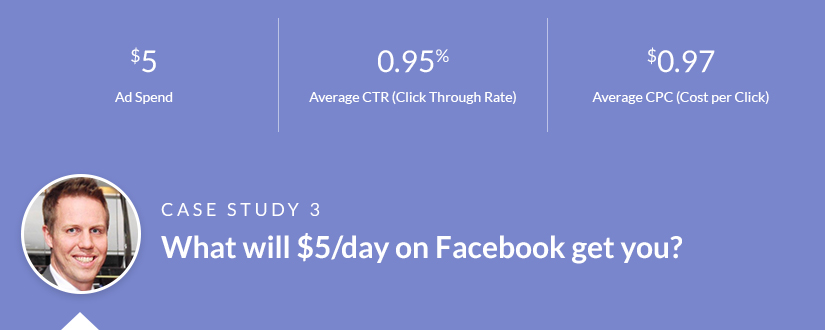
Case Study # 3 – What Will $5/day on Facebook Get You?
With the tremendous growth of businesses interest in advertising and marketing their product on Facebook, Buffer did a small experiment to see how a minimal investment of $5 on Facebook Ads can give them.
The $5 ad spend was tested for different objectives such as page likes, clicks to website and effects on boosted post.
And here are the results they achieved for every $5 spend on each of the activity below;
Page Likes – 9 Likes per day
Clicks to the homepage / landing page – 1 per day
Boosted post – 787 new people reached
So there is something for business seen on a small budget.
Here is the audience targeting they set;

As you can see, they’re targeting people who are interested in social media, excluding their fans.
Furthermore, just to give you an example of creating a Killer Facebook Ad, see this the ad buffer created for the Page Likes campaign.

Apparently, this ad comes across as very social/human (since it’s showing the team) – which is why it’s been working well for a “like” campaign.
So to get the best bang out of your Facebook Ads even on a small budget, try zooming in your target audience and create ads copy that reflect or resonate with them.
Lesson Learned # 7 – If you want to test the Facebook Ads waters or generate buzz for your product, a small budget can also do good for you. Not only it creates awareness for your business, but you might also score a handy traffic and some sales too in the process.
Lesson Learned # 8 – You don’t need a large budget to succeed with Facebook Ads. If you target and optimize the ads well, you still can get a good traction regardless of your objective.
Lesson Learned # 9 – When targeting for page likes, always make sure that you Exclude your current page followers.
Lesson Learned # 10 – Make sure the ad image / creative you select, must match with the objective of the ad.
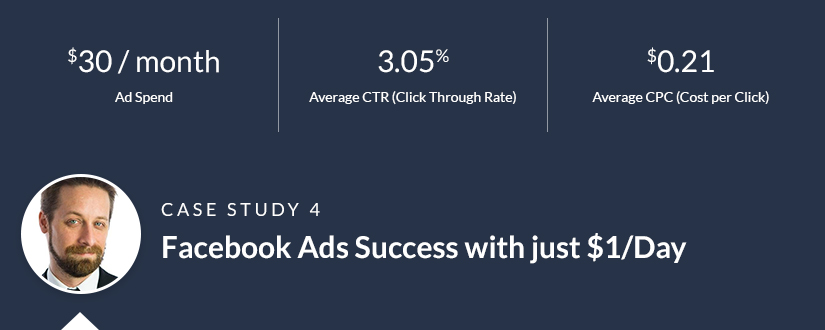
Case Study # 4 – Facebook Ads Success with just $1 per Day
Similar to the Buffer experiment, this case study by Brian Carter , a prominent Facebook Marketing and Advertising Expert and Bestselling author of the book “ The Like Economy” showed that even investing a minimum of $1/day on Facebook Ads can give you a significant reach.
By consistently investing $1/day for 30 days, he was able to reach 120,000 people or 4000 people every day.
He in an active user of most advertising platforms and this is what he found as the cost to reach 1000 people using popular advertising channels.

Facebook Ads are far cheaper than the legacy advertising solutions (newspaper, tv, etc.), but also left behind its online competitors (Adwords and LinkedIn).
The objective of this case study or experiment was to show that even if you start with a minimal budget, Facebook Ads can still prove beneficial.

Most businesses can afford to spend $1/day on Facebook, can’t they?
Lesson Learned # 11 – Budget is or should not be a roadblock for virtually any business. $1/day or $30/month is not a big deal for most businesses.
Lesson Learned # 12 – Even if you are investing more on other channels for traffic or lead generation successfully, it doesn’t hurt to spend a small proportion on Facebook Ads. You might get the same number of traffic, but the overall cost will be much cheaper than all other alternatives.
Check out more details about this case study here.

Case Study # 5 – $14,114 in revenue from $8,240.17 spent in Facebook Ads
This case study is purely about generating leads than anything else.
Brian Moran , the founder of SamCart , used Facebook As to sell his courses and training products .
He tested three different targeting groups where;
- One group was his existing email list.
- The 2nd group was the lookalike version of his email list.
- And the third was custom audience he created using the native+ advanced targeting features of Facebook.
And after spending $8240 on the ads on these groups, he was able to get;
- $3496 in Sales from $1800 in ad spend from group 1
- $1546 in Sales from $895 in ad spend from group 2
- $9039 in Sales from $5153 in ad spend from group 3

Although all of the ads returned an ROI of 2:1, the 3rd group clearly outperformed the others.
So as seen, changing and testing around with your targeting can give you better results than standard targeting.
Typically existing subscribers are considered a gold mine to be reaped over and over but Brian proved that you can still succeed with Facebook Ads if you just get you targeting right.
Even if you don’t have a big list of subscribers, using native targeting features of Facebook can bring you in front of the right viewers.
Lesson Learned # 13 – Retarget or advertise your offer to existing subscribers as well. This is particularly helpful if you want to convert your blog subscribers into warm leads or paying customers .
Lesson Learned # 14 – Use lookalike audience effectively. Brian created a lookalike audience from his existing email subscribers that brought in $1546 in revenue from $895 in ad spend.
Lesson Learned # 15 – Fine tune your advertising to narrow down to your targeted audience as much as possible. Brian got the best response from the custom targeting he set up.
Lesson Learned # 16 – Just beside A/B testing your Facebook ad copy , split test between your targeting groups too. When seeing results from the third group, Brian invested more in it, and the results were equally rewarding.
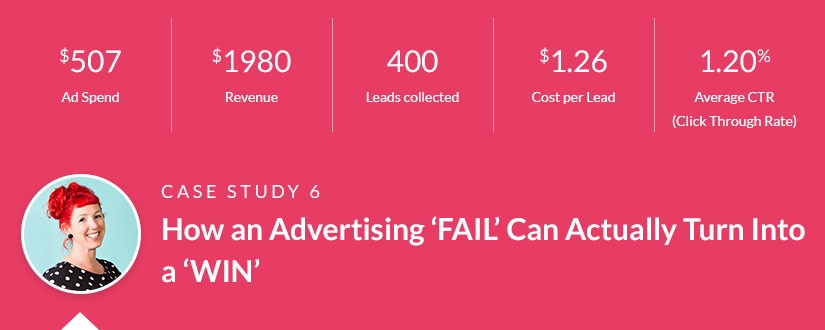
Case Study # 6 – How an Advertising “FAIL” Can Actually Turn Into a “WIN”
This case study is rather interesting as it started off from a failure before they got their winning aha-moment.
Angela Ponsford started a Facebook Ad campaign for her client who wanted to sell a high-priced $990 home renovation program to women’s in 30-40 age range across the USA.
The idea was to build an email list via Facebook Ads and later show them ads for Free Webinar that will lead to the program she wants to sell.
When they run the ads, they performed well, but most of the people that were engaging with it were not the actual audience perceived.
She thought women in the 30-40 age group would take more interest in her program, but women above 45+ were engaging most with her ad and content.
The first few days just yielded in 2 sign ups at the cost of nearly $27 each. So she optimized the ad targeting and the ad copy in line with the results they achieved earlier.

The second run significantly improved the cost/lead, dragging it down to 4 leads at $5.43 each.
After several rounds of testing and tuning with targeting and ad copies, she was able to bag in 400 leads at a cost $507 and some happy customers that went on buying the program.

One of their best performing ads was shared 14 times which indicated that the ad copy was talking to the customer and performed well.
It is essential that you keep on monitoring and optimizing your campaign- especially at the start. Angela was able to reduce the cost/lead from $27 to just $1.27 in the end by continually improving the campaign in the line of results she was getting.
Unless you have a large budget to spend, test your campaign in small budget / test runs until you find what’s working or you might end up spending a lot of money with little results.
Lesson Learned # 17 – There is no barrier to the type and cost of the product you are selling – you can even sell a high priced product using Facebook Ads .
Lesson Learned # 18 – Do some preliminary ad test to fine tune on the audience and then invest more budget where you get the most gold.
Lesson Learned # 19 – The ideal audience perceived by you might not always be correct.
Lesson Learned # 20 – Sometimes the simplest of thing are most effective. By changing the word “Webinar” to “Workshop” on the ad copy, the CTR and leads doubled.
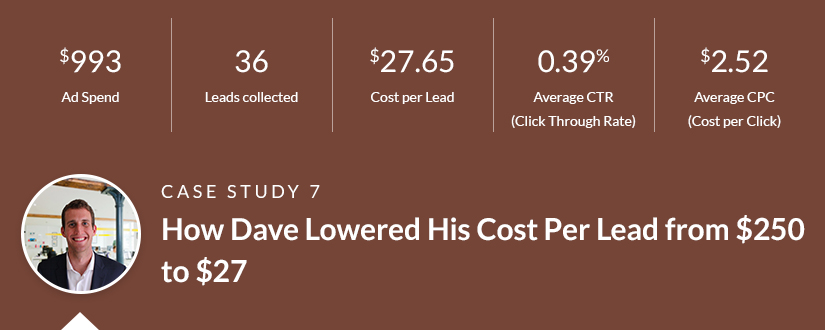
Case Study # 7 – 89% cheaper cost / lead with Facebook Ads
Google Adwords in arguably the most used platform when it comes to online advertising. Hundreds of thousands of businesses use its daily traffic and leads.
But, it’s still expensive to reach for some.
Dave Rogenmoser of The Market Results, identified that cost/lead for a high-end app and web development company ranges between $250 – $1000 / lead on Adwords.
Although $250/lead was a good deal for a $80,000 contract, they wanted more.
Fast forward, they leveraged the narrow-down targeting capabilities of Facebook to target startups that might be in need of app development .
Dave mentioned that the hardest part of the campaign for them was to set targeting for their audience. As we saw from earlier case studies, narrowing down on your target audience is much more beneficial than broadening it.
And he did exactly just that- zoomed in on funded startups that might be in need of app development.
With a spend of $993 across a week, they were able to score 34 leads which was far much quicker and cheaper than Google Adwords.

From the first week of the run, they were able to decrease their cost/lead to $28 a piece, 89% cheaper than what it takes from Adwords.
Want similar results? Check out our free targeting training here.
This goes to show you that how cost effective leads from Facebook can turn out to be when compared with other options.
Lesson Learned # 21 – Facebook Ads are cost effective as compared to Google Adwords when it comes to B2B leads generation.
Lesson Learned # 22 – Facebook ads provide narrower targeting which helps you to laser in on your ideal audience. Setting up the correct targeting is one of the essential parts of your campaign.

Case Study # 8 – 7 Mistakes Made While Spending $234.07 on Facebook Ads
At Connectio we often hear customers saying that they have none or very limited success via Facebook Ads. Either it was not giving the desired results or is turning out to be expensive for them.
This case study is especially useful for such Facebook Ad starter business that is struggling to find their way.
Philip Kleudgen, a web development, and marketing specialist for restaurant owners, shares his experience of how he started off with Facebook Ads- with no prior experience .
As like more people starting off with Facebook Ads, he made some classic mistakes such as;
- Targeting was not set correctly. He was targeting a very little set of individuals.
- Used only one image and didn’t A/B test between different images or ad copies.
- Wasn’t tracking conversions correctly due to missing or improper configuration
- Keep running ads that were unprofitable.
After running the ad for week or so, he spent $234 on Facebook Ads with a meager CTR and earned less than the actual ad spend.
Although, he was at a loss at this campaign some valuable lessons learned.
But at such stage, most businesses give up rather than realizing their mistakes and optimizing their campaign accordingly.
So it’s important to review and analyze performance and mistakes in your Facebook Ads campaign before ruling the platform as a failure.
Lesson Learned # 23 – Take some pre-campaign time to research and identify your targeted audience. Ideally, have a separate ad set for each unique audience you are targeting.
Lesson Learned # 24 – If your objective is lead generation or sales, you need to set your conversion tracking and do it right. If you aren’t tracking your conversions correctly how would you analyze performance?
Lesson Learned # 25 – Have multiple images and copies of your ad in hand before starting a campaign.
Lesson Learned # 26 – Don’t spend that much money on ads or campaigns that are not giving any result.
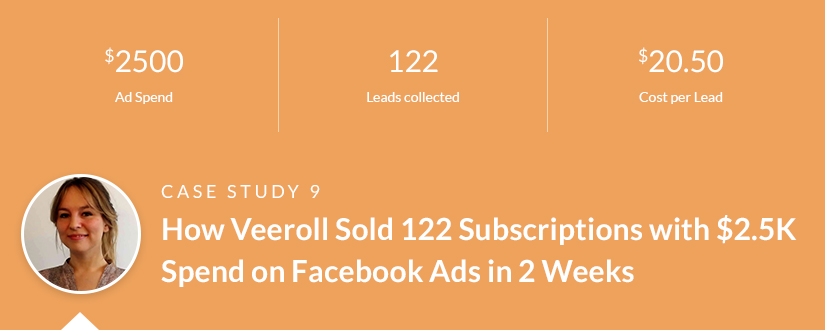
Case Study # 9 – How Veeroll Sold 122 Subscriptions with $2.5k Spend on Facebook Ads in 2 Weeks
This case study is another classical example that Facebook can be effectively used to generate leads for B2B businesses. B2B businesses. It also shows how businesses can gain better results by using video ads and continually optimizing the campaign to improve performance. Veeroll along with other places started off their campaign on Facebook and sent all traffic to a webinar funnel . They were also tracking website conversions to know how many people referred from Facebook were converting on that landing page.
They set their targeting and created the ads. Initially, they were getting a higher CPC.

Although their primary objective was to show the video ads, they also tested the text ad along with it and they saw a huge difference between both.
This the stats on their text ad;

And compare that to the video ad;

They spent a little more on the video ads, but have 18X more engagement and were 3.5X more than the text ads.
So seeing the video ads were proving better, they went on creating multiple video ads.
This is one of the video ads they were using.

Specifically, implementing retargeting on the website helped them lower their CPC and improve their conversions.
At the end of 2 weeks campaign, they were able to have 122 signups that resulted in $11,000 of monthly revenue that too just from a $2500 in ad spend.

That is almost 400% is profit against the cost of Facebook Ads, not to mention that the lifetime value of these customers will be way much than this.
Lesson Learned # 27 – Don’t get faltered from initial road bumps. Review the performance and capitalize where most performance is achieved. Such as mobile users were engaging far more than desktop users in this case so apparently it makes sense to pour more budget here.

Lesson Learned # 28 – Retargeted traffic gave better conversion then the cold traffic. Veeroll has the lowest CPC and conversion from retargeted ads.

Lesson Learned # 29 – Don’t just stick to conventional ad styles. Try video ads too. They have incredible engagement and lets you communicate more message than what it takes from text and image ads.
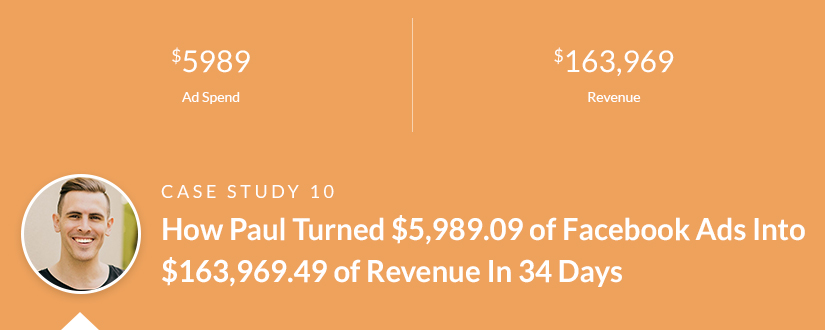
Case Study # 10 – Reaping $163,969 in revenue from $5989 of ad spend in just 34 days
This is an absorbing Facebook Ad Case Study as it not only achieved a remarkable result but worked on an approach that will work in any niche – yes any niche. It is also very helpful for startup businesses that have none or small following and email list.
Paul Romando’s Facebook Ad’s campaign for his client returned a staggering $163,969 in revenue from a mere $5989 in ad investment.

That’s an insane 2737.80% of return in just 34 days of the campaign.
Paul’s success formula was simple.
Rather than going for the hard sell, he created a Facebook funnel, where leads first opted in on content ( lead magnet) around a product.
And later, for all those that opted in, Paul would show a different ad set that directly takes them to the sale page.
He calls this is the Elope Approach.
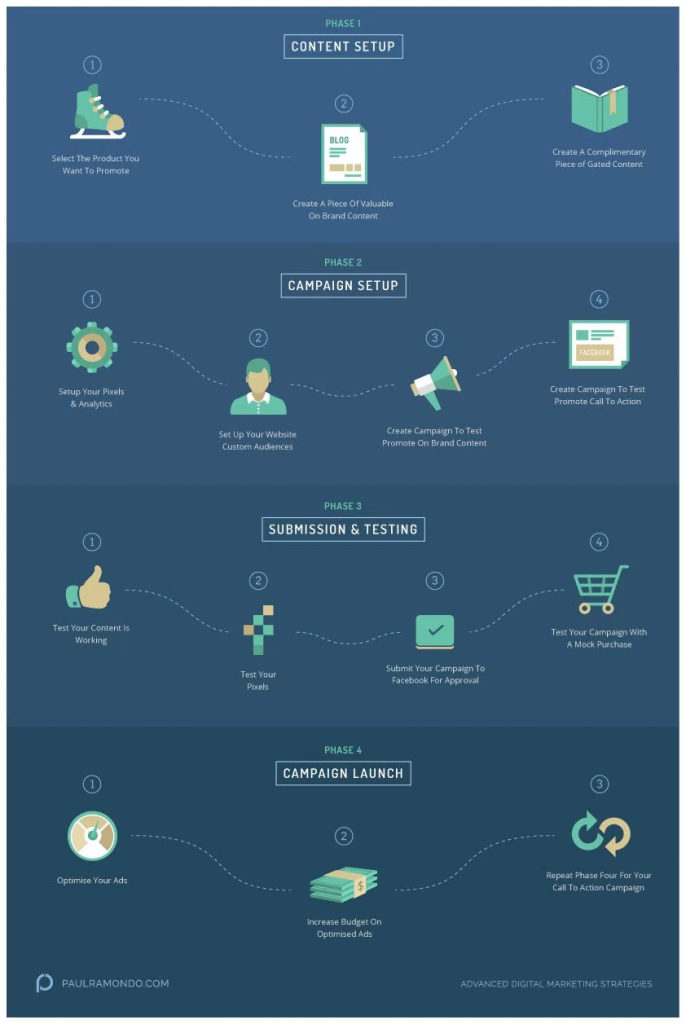
His multi-step Facebook Ad Strategy builds up a connection with your targeted audience before going for the sale. This helps in nurturing leads and segmenting people that are most likely to convert.
Particularly important was the Facebook Ad relevance score. A high Facebook Ad relevance score helped your ad not being flagged by Facebook and delivered to your targeted audience.
So when he showed the sales ads to his existing audience, a high relevance score for imminent as these people already knew him.
For most B2B businesses having a Facebook Sales Funnel is crucial. It might sound a lot of work but gains are immense, and you can use it over and over again.
Lessons Learned # 30 – Rather than going straight for sales, develop a Facebook funnel through a lead magnet. Once you have subscribers in your funnel, nurture them with you offer ads.
Lessons Learned # 31 – Use different ads / ad sets for the retargeted audience / warm leads. Since they already know about your product, take them straight to your money page.
For example, create a different ads / ad set for cold and warm leads and make sure that you exclude each one of them in the targeting set.
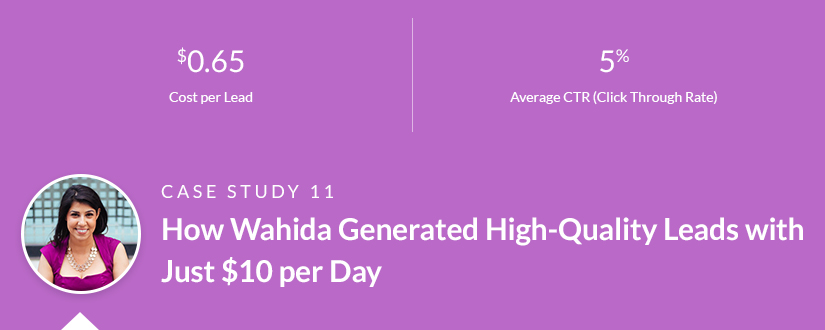
Case Study # 11 – How Wahida Generated High-Quality Leads With Just $10/Day
Sending people straight to a sales page might work in commodity niches such as online stores, but for B2B services it’s essential to capture the leads first.
This case study came from Wahida Lakhani, one of the students of Claire Pelletreau from her Ad Consultant Incubator program. She was able to manage a very low cost / lead for a client in health and fitness niche.
The idea was same as Paul Romano – generate leads using a lead magnet and then move on for the sale.
But she tweaked it a bit.
Rather than sending them to a lead magnet straight away, she added another layer. She sent the traffic from Facebook ad to a high-quality article on the blog and added a lead magnet as the content upgrade.

The original article was on creating “Easy Chocolate Peanut Butter Bars” but she added the details of the lead magnet “6 Vegan and Gluten-Free Recipes.”
This is uber awesome, provided you have an ultra high-quality article that drives CTR from Facebook and an equally irresistible lead magnet.To ensure they provided the detail of valuable content in the ad, she also added the lead magnet detailed information in the FB ad.
The results were 10/10 relevance score from Facebook, high CTR ( 5%) and lead cost at just $0.65.
Want 10/10 relevance scores also? Check out our free targeting training here.
This was far less than the industry standard in health and wellness. So regardless of how competitive your niche is, there is still an opportunity for to score dirt-cheap leads.
Lesson Learned # 32 – Having a high-quality content helps in generating high CTR, better engagement, and lead generation.
Lesson Learned # 33 – Use your Facebook Ad effectively to list all the value you are providing. This will make your case stronger and gives the reader more reason to interact with your ad.
Lesson Learned # 34 – With a well thought out plan / funnel / strategy, you can shatter any industry benchmarks no matter how competitive your niche is.

Case Study # 12 – How Mary Got 532 Subscribers in 43 days Using Facebook Ads
For startup businesses and bloggers, getting new subscribers for their blog is often challenging. They might end up producing high-quality content but fail to attract the subscribers/ optins they would expect.
This case study will help you understand that how can you use Facebook Ads to generate more subscribers for your blog.
Mary Fernandez shows how she gained new blog subscribers for just $0.43 each using video ads.

One common thing that she experienced in building blog subscribers for her clients was that personalizing the ad gave better results than a stock-photo ad.
Such as these are some examples of a personalized ad.

And this too;

Why these ads?
View the Facebook from the standpoint of a potential subscriber.
They are probably surfing Facebook to see what their friends are doing, following up with family and socializing but not to view ads.
If your ad looks like a traditional ad, there is a high chance that they will ignore it. But if they see something relevant or something which might not be another ad from the laundry, they are more likely to engage.
So where possible try to use a personal looking photo of you or your employees, instead of stock photos.
Lessons Learned # 35 – Facebook Ads can be used for any objective – even if its finding or increasing new subscribers for your blog.
Lesson Learned # 36 – Keep your ads as personal as possible. Your audience will be more likely to interact with your ad if it has a human effect / touch.
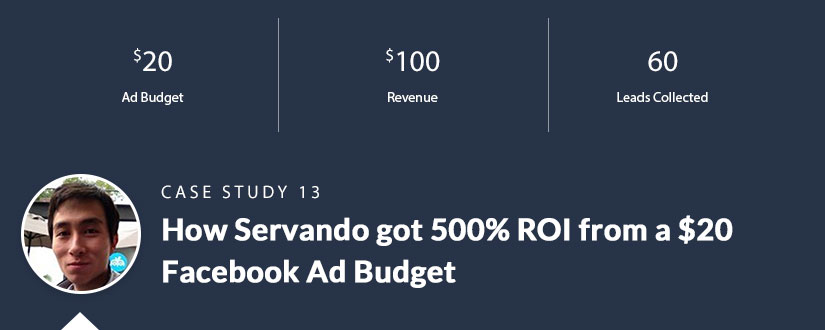
Case Study # 13 – How Servando got 500% ROI from a $20 Facebook Ad budget
This case study is especially useful for people and businesses that don’t have a product of their own but are promoting affiliate products.
We have often seen our customers using Facebook Ads for promoting affiliate offers, but they seem to struggle in creating an effective strategy.
One of the biggest mistakes they make is not using the landing page effectively.
It’s not difficult or impossible to send traffic from Facebook. If you set your targeting right, you will still be able to get the required traffic.
However, if you are promoting affiliate products on Facebook , don’t send them straight to a sales page but to a “bridge” page first.
This is what Servando Silva of Stream-Seo did. For the affiliate offer, he was promoting using two landing pages.
1 – One page that had a description of the offer and a Free Trial button that took them straight to the sales page.

2 – One that has an opt-in form ( just for email) and after submitting will lead to the sales page.

He spent overall $20 on ads on both the ads pages and was able to earn $100 in commission and 60 valuable leads.
Though the sales came from the first page, he was able to score valuable leads via the second ad and landing page.
Not only did he earn $80 over his $20 spend, but he also grew his list which he can leverage in the future.

From the 198 people that clicked on from his Facebook Ads , almost 119 clicked on to the affiliate link. So this shows that bringing quality traffic certainly works in your favor.
Lesson Learned # 37 – If you want the best ROI from your campaigns, don’t just focus on the Facebook Ad part – plan ahead where you will send the traffic and how will you capitalize on them.
Lesson Learned # 38 – Create multiple funnels and objectives from different ad sets and landing pages. Such as in this case he tested two ads on two different landing pages giving him multiple segmented audiences.
So there you have it – an in-depth review of the best handpicked Facebook Ads Case studies from nearly all types of businesses with variable objectives.
By reviewing the above case studies, it is evident that the success of Facebook Ads lies in multiple things. But it’s also clear that budget is not a primary factor, and you can succeed with even minimal of the budget.
What’s your favorite case study?

What Are Facebook Custom Audiences? (And Why You Should Be Using Them)
Facebook advertising can be used to generate leads, drive traffic to your website, promote services, sell products, and much more. However, advertising on Facebook can be a daunting prospect for many. There are no guarantees that you will reach your target audience, let alone recoup the cost of the ads. So can using Facebook custom audiences improve your ad campaign’s chances of success?
In this article, we will…
- Look in depth at exactly what Facebook custom audiences are
- Discuss how they can help your ad campaign achieve its goals
- Consider case studies where they have been used successfully
What are Facebook custom audiences?
Facebook custom audiences allow you to reach out and reconnect with customers you already know via adverts on Facebook. A custom audience is a list, or group, that Facebook creates, based on people that have previously shown an interest in your website, business, product, app, or services. These people are your website visitors, customers, leads and followers; the target market with whom you want to share your adverts .

You can also select to exclude people who have already completed a specific action from a custom audience. For example, you can exclude people who have already made a purchase of a particular product on your site. This ensures you aren’t advertising to the ‘wrong’ people and wasting your ad budget.
There are four different ways to create Facebook Custom Audiences. Let’s have a look at each of them…
Custom audiences from your customer list
Facebook enables you to use pre-collected customer data to reach out and connect with your target market through advertising. Simply upload a list of contact information, like phone numbers or email addresses into your Facebook Ads Manager . Facebook will then create a custom audience using this info, and display your ads to this audience.
Custom audiences from your website
Another option is to display adverts to those who have already visited your website and shown an interest in your content, products, or services. Add a Facebook Pixel to your website so Facebook can track your website data. Then create custom audiences consisting of people who have visited your website, or specific pages or posts. Target ads at these groups of potential customers to remind them of the content on your site they were browsing.
Custom audiences from your mobile app
A third possibility is to create custom audiences from your mobile app users . Using the Facebook SDK , you can pass data from your app to Facebook. You can then specify who you want to include or exclude from your custom audiences. Ads could target those who have installed your app but haven’t engaged with it yet, or people who are yet to upgrade to the premium version of your app.
Engagement custom audiences
Lastly, Facebook custom audiences can be made up from people who have previously engaged with your content across the Facebook family of apps and services. This could be people who have watched your videos on Facebook, followed you on Instagram, opened a lead form or joined an event you have organised. Once you have created these custom audiences, you can target ads at people who have taken these actions.
Once these custom audiences have been created, if people in these groups are present on Facebook, your Facebook ads will then be displayed to them when they log on to Facebook.
Why you should use custom audiences
So now we know what Facebook custom audiences are. But how can they benefit your ad campaign and business and do they really get results?
Let’s next have a look at the different ways Facebook Custom Audiences can be used to help businesses achieve their goals . Here we will examine a variety of case studies , using the data provided to help us to understand how Custom Audiences can be effective.
Generate leads
Using Facebook custom audiences is a great way to re-connect and collect leads from those who have already shown an interest in your website. A great example of this is the case study of Sinpas GYO .

Sinpas GYO is a well known Turkish real estate agency. They used custom audiences as part of their advertising campaign to target potential buyers. After running an initial advertising campaign on Instagram, they then created custom audiences based on those who had already interacted with their brand through the Instagram ads.
Their second ad campaign on Facebook, targeting only the custom audiences, contained two click ads with self-populating lead generation forms. This approach saw the number of leads collected increase dramatically. During November 2016, they had a 29% increase in leads compared to their previous campaign, which did not use custom audiences.
Sinpas GYO also found that the cost per lead fell. This was because those they were reaching already knew of, and had shown enthusiasm for, the business. The ad campaign actually had a 37% lower cost per lead compared to previous campaigns. As you can see, Facebook custom audience played a significant role in improving the outcomes for this real estate agent.
Drive traffic to your website
As well as increasing leads, you can also use Facebook custom audiences to increase brand awareness and drive your current followers and customers to your website. Favi, a Czech-based online furniture and accessories store, has seen this theory work in practice .

Favi created an ad campaign focused on boosting brand awareness, driving traffic to its website, and ultimately increasing online sales and conversions. The ad campaign consisted of Facebook custom audiences based on customer data, such as email or newsletter lists. They also built lookalike audiences based on these existing customer groups. (A lookalike audience is a group that is created by Facebook, and is based on similar demographics, likes and other attributes, of a custom audience).
The results of their ad campaign were impressive. By targeting existing customers, and new customers with matching characteristics, the ads reached and engaged with 600,000 individuals every day. This saw a 2.1x increase in people reached, and a 2.6x increase in web traffic from Facebook, compared to their previous ad campaign.
Increase mobile app installs
If you are looking to create an ad campaign aimed at increasing your mobile app installs then using custom audiences can help you achieve this goal. This is shown through the results accomplished by the mobile games studio Treasure Hunt .

Treasure Hunt created a custom audience consisting of its most active players. Then they built lookalike audiences based on the custom audience, at whom they targeted their ads. Compared to their previous campaign, when they had not used custom or lookalike audiences, they achieved a 9% higher conversion rate. They also had a 21% lower ad cost per app install.
Increase online sales
If you are running an eCommerce store then an ad campaign using custom audiences can help increase your sales. It is far easier to sell a product or a service to those who are already customers. Or to people who have already shown an interest in your niche. So re-connecting through ads with your established and prospective customers will encourage people back to your store, and ultimately help increase sales. Let’s look at the evidence for this with a case study of Wasted Heroes .

Wasted Heroes is a streetwear brand from the UK. Their case study shows how they used Facebook custom audiences to increase their sales and break into the US fashion scene. Firstly, they created custom audiences using their existing customer’s data, to retarget their UK audience. They then created lookalike audiences, based on their custom audiences, but tweaked specifically to reach people in the US.
During their campaign period, from September to November 2016, data showed a 2x increase in web traffic. And a 150% return on ad spend. Thanks to the lookalike audiences, Wasted Heroes also saw a 3x increase in sales in the US.
Increase in-store visits

Research from the Danish supermarket Bilka , shows how it used Facebook custom audiences to increase the number of customers their physical stores received. Firstly, Bilka ran a series of ads targeting a broad audience of men and women aged 24 – 65. Next, during the second round of the ad campaign, they created custom audiences. Bilka included anyone who had engaged with the initial ads in these audiences, as well as those who had visited a store after seeing an ad. Bilka then retargeted these custom audiences with further ads.
Between August and October 2017, Bilka stores saw a significant increase in footfall. During this time there were 45,000 store visits. 7.8% of people who saw an ad visited the store. And 15% of people who visited the store, revisited the store after being added to a custom audience and retargeted with an ad.
Promote a service
Using Facebook custom audiences to promoting a service can also be effective. Evidence for this can be found in the AKBank case study .

AKBank used custom audiences to target consumers who had already expressed an interest in taking out a loan. During their ad campaign, they saw, on average, over 500 conversions a day.
AKBank created their custom audiences by re-targeting people who had already visited their personal loan pages on their website. They instructed the custom audiences to exclude those who had already been assessed for a loan. And then used Facebook’s Core Audience Targeting to pinpoint those with high credit scores.
During their campaign in April 2017, AKBank saw 15% of loan approvals originate from Facebook advertising. Importantly, compared to other marketing channels who don’t offer a custom audiences service, AKBank’s Facebook ad costs per loan were 70% lower.
Final thoughts on using Facebook custom audiences
Want more help with marketing your band on Facebook? Check out these other Revive.Social Facebook guides:
- Facebook Ads vs. Boosted Posts: Which Should You Choose?
- How to Use Facebook Advertising Campaigns to Boost Your Business
- Grow Your Reach Today With These Facebook Video Marketing Tips
- 5 Ways to Use Facebook Live For Business + 5 Things to Do Before You Go Live
- 6 Facebook Business Page Tips You Don’t Want to Miss Out On
Are you ready to implement custom audiences into your Facebook ad campaigns? Please share your thoughts in the comments below…

By Megan Jones

Revive Old Posts
Grow your social media following and keep your followers engaged by sharing evergreen content from your WordPress website.
Most Searched Articles
How 3 key features of the facebook ads manager can improve campaign results.
Despite its advancing age, Facebook is still a giant in the social media world. For online marketers, it’s particularly notable thanks to its robust advertising system. However, Facebook now offers so many options through the Facebook Ads Manager ...
4 Instagram Alternatives for Marketers to Watch in 2022
Platforms like Facebook, Instagram, and Twitter have become ubiquitous in western culture, but there are always new platforms trying to rise to the surface. In this article, we’re going to examine some of the social media platforms that hope to ...
How to Regram Images the Legal and Moral Way
A "regram" is seen on a daily basis for many Instagram users - and many companies, or influencers, use regramming for high-quality, user-generated content. What's regramming? It's the act of using someone else's Instagram photo and resharing it on ...
Handpicked Articles
Social media seo: how to optimize your profiles on major platforms.
Search Engine Optimization (SEO) isn’t just important on websites. It’s also crucial when it comes to your social media content. Social media profiles often rank above actual websites on search engines, so you want to make sure your profiles are ...
Revive Old Posts Review: How 3 Months of ROP Transformed Our Twitter Account
Here at Revive.Social, we believe in the power of data. We know automation works, and we know our Revive Old Post plugin is an effective way to automate your social media presence and boost high-quality content on your WordPress site. However, ...
11 Facebook Case Studies & Success Stories to Inspire You
Published: August 05, 2019
Although Facebook is one of the older social media networks, it's still a thriving platform for businesses who want to boost brand awareness.

With over 2.38 billion monthly active users , you can use the platform to spread the word about your business in a number of different ways -- from photos or videos to paid advertisements.
Because there are so many marketing options and opportunities on Facebook, It can be hard to tell which strategy is actually best for your brand.
If you're not sure where to start, you can read case studies to learn about strategies that marketing pros and similar businesses have tried in the past.
A case study will often go over a brand's marketing challenge, goals, a campaign's key details, and its results. This gives you a real-life glimpse at what led a marketing team to reach success on Facebook. Case studies also can help you avoid or navigate common challenges that other companies faced when implementing a new Facebook strategy.
To help you in choosing your next Facebook strategy, we've compiled a list of 11 great case studies that show how a number of different companies have succeeded on the platform.
Even if your company has a lower budget or sells a different product, we hope these case studies will inspire you and give you creative ideas for your own scalable Facebook strategy.

Facebook Brand Awareness Case Studies:
During the 2017 holiday season, the jewelry company Pandora wanted to boost brand awareness in the German market. They also wanted to see if video ads could have the same success as their other Facebook ad formats.
They began this experiment by working with Facebook to adapt a successful TV commercial for the platform. Here's a look at the original commercial:
The ad was cut down to a 15-second clip which shows a woman receiving a Pandora necklace from her partner. It was also cropped into a square size for mobile users. Pandora then ran the ad targeting German audiences between the ages of 18-50. It appeared in newsfeeds and as an in-stream video ad .
Results: According to the case study , the video campaign lifted brand sentiment during the holiday season, with a 10-point lift in favorability. While Pandora or the case study didn't disclose how they measured their favorability score, they note that the lift means that more consumers favored Pandora over other jewelers because of the ad.
Financially, the campaign also provided ROI with a 61% lift in purchases and a 42% increase in new buyers.
Video can be memorable, emotional, and persuasive. While the case study notes that Pandora always had success with ads and purchases, the jeweler saw that a video format could boost brand awareness even further.
In just 15 seconds, Pandora was able to tell a short story that their target audience could identify with while also showing off their product. The increase in favorability shows that audiences who saw the ad connected with it and preferred the jeweler over other companies because of the marketing technique.
Part of Pandora's success might also be due to the video's platform adaptation. Although they didn't create a specific video for the Facebook platform, they picked a commercial that had already resonated with TV audiences and tweaked it to grab attention of fast-paced Facebook users. This is a good example of how a company can be resourceful with the content it already has while still catering to their online audiences.
Rock & Roll Hall of Fame
The Rock & Roll Hall of Fame , a HubSpot customer, wanted to boost brand awareness and get more ticket purchases to their museum. Since they'd mainly used traditional customer outreach strategies in the past, they wanted to experiment with more ways of reaching audiences on social media.
Because the museum's social media team recognized how often they personally used Facebook Messenger, they decided to implement a messaging strategy on the Hall of Fame's official business page.
From the business page, users can click the Get Started button and open a chat with the Hall of Fame. Through the chat, social media managers were able to quickly reply to questions or comments from fans, followers, and prospective visitors. The reps would also send helpful links detailing venue pricing, events, other promotions, and activities in the surrounding area.
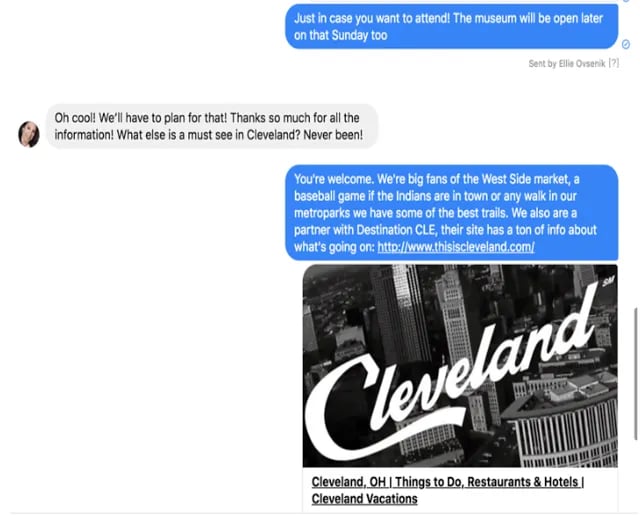
Since the Messenger launch, they claim to have raised their audience size by 81% and sales from prospects by 12%. The company claims that this feature was so successful that they even received 54 messages on an Easter Sunday.
Being available to connect with your audiences through Messenger can be beneficial to your business and your brand. While the Rock & Roll Hall of Fame boosted purchases, they also got to interact with their audiences on a personal level. Their availability might have made them look like a more trustworthy, friendly brand that was actually interested in their fanbase rather than just sales.
Facebook Reach Case Study:
In early 2016, Buffer started to see a decline in their brand reach and engagement on Facebook due to algorithm changes that favored individuals rather than brands. In an effort to prevent their engagement and reach numbers from dropping even further.
The brand decided to cut their posting frequency by 50%. With less time focused on many posts, they could focus more time on creating fewer, better-quality posts that purely aimed at gaining engagement. For example, instead of posting standard links and quick captions, they began to experiment with different formats such as posts with multi-paragraph captions and videos. After starting the strategy in 2016, they continued it through 2018.
Here's an example of one an interview that was produced and shared exclusively on Facebook.
The Results: By 2018, Buffer claimed that the average weekly reach nearly tripled from 44,000 at the beginning of the experiment to 120,000. The page's average daily engagements also doubled from roughly 500 per day to around 1,000.
In 2018, Buffer claimed that their posts reached between 5,000 to 20,000 people, while posts from before the experiment reached less than 2,000.
Although Buffer began the experiment before major Facebook algorithm changes , they updated this case study in 2018 claiming that this strategy has endured platform shifts and is still providing them with high reach and engagement.
It can be easy to overpost on a social network and just hope it works. But constant posts that get no reach or engagement could be wasted your time and money. They might even make your page look desperate.
What Buffer found was that less is more. Rather than spending your time posting whatever you can, you should take time to brainstorm and schedule out interesting posts that speak directly to your customer.
Facebook Video Views Case Studies:
Gearing up for Halloween in 2016, Tomcat, a rodent extermination company, wanted to experiment with a puppet-filled, horror-themed, live video event. The narrative, which was created in part by their marketing agency, told the story of a few oblivious teenage mice that were vacationing in a haunted cabin in the woods. At peak points of the story, audiences were asked to use the comments to choose which mouse puppet would die next or how they would die.
Prior to the video event, Tomcat also rolled out movie posters with the event date, an image of the scared mouse puppets, and a headline saying, "Spoiler: They all die!"
Results: It turns out that a lot of people enjoy killing rodents. The live video got over 2.3 million unique views , and 21% of them actively participated. As an added bonus, the video also boosted Tomcat's Facebook fanbase by 58% and earned them a Cyber Lion at the 2017 Cannes Lions awards.
Here's a hilarious sizzle reel that shows a few clips from the video and a few key stats:
This example shows how creative content marketing can help even the most logistical businesses gain engagement. While pest control can be a dry topic for a video, the brand highlighted it in a creative and funny way.
This study also highlights how interactivity can provide huge bonuses when it comes to views and engagement. Even though many of the viewers knew all the rats would die, many still participated just because it was fun.
Not only might this peak brand interest from people who hadn't thought that deeply about pest control, but interactivity can also help a video algorithmically. As more people comment, share, and react to a live video, there's more likelihood that it will get prioritized and displayed in the feeds of others.
In 2017, HubSpot's social media team embarked on an experiment where they pivoted their video goals from lead generation to audience engagement. Prior to this shift, HubSpot had regularly posted Facebook videos that were created to generate leads. As part of the new strategy, the team brainstormed a list of headlines and topics that they thought their social media audience would actually like, rather than just topics that would generate sales.
Along with this pivot, they also experimented with other video elements including video design, formatting, and size .
Results: After they started to launch the audience-friendly videos, they saw monthly video views jump from 50,000 to 1 million in mid-2017.
Creating content that caters to your fanbase's interests and the social platform it's posted on can be much more effective than content that seeks out leads.
While videos with the pure goal of selling a product can fall flat with views and engagement, creative videos that intrigue and inform your audiences about a topic they relate to can be a much more effective way to gain and keep your audience. Once the audience trusts you and consumes your content regularly, they might even trust and gain interest in your products.
Facebook App Installs Case Study:
Foxnext games.
FoxNext Games, a video game company owned by 20th Century Fox, wanted to improve the level of app installs for one of its newest releases, Marvel Strike Force. While FoxNext had previously advertised other games with Facebook video ads, they wanted to test out the swipe-able photo carousel post format. Each photo, designed like a playing card, highlighted a different element of the game.
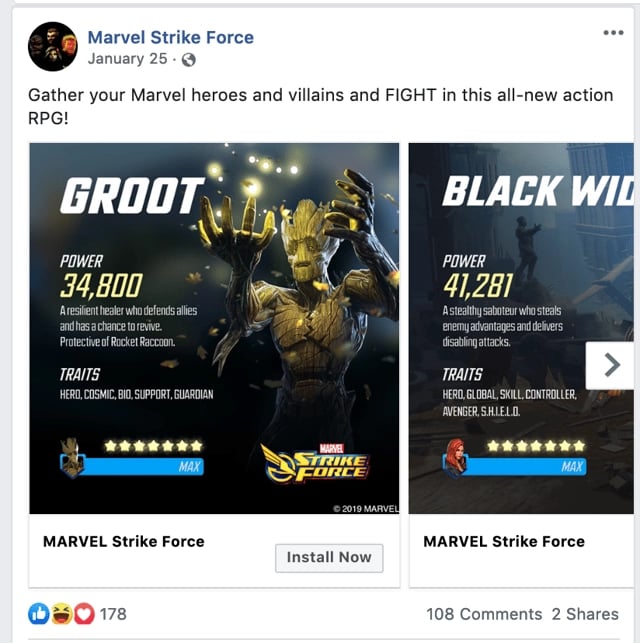
The add offered a call-to-action button that said "Install Now" and lead to the app store where it could be downloaded. FoxNext launched it on both Facebook and Instagram. To see if the carousel was more efficient than video campaigns, they compared two ads that advertised the same game with each format.
Results: According to Facebook , the photo ads delivered a 6% higher return on ad spend, 14% more revenue, 61% more installs, and 33% lower cost per app install.
Takeaways If your product is visual, a carousel can be a great way to show off different elements of it. This case study also shows how designing ads around your audience's interest can help each post stand out to them. In this scenario, FoxNext needed to advertise a game about superheroes. They knew that their fanbase was interested in gaming, adventure, and comic books, so they created carousels that felt more like playing cards to expand on the game's visual narrative.
Facebook Lead Gen Case Study:
Major impact media.
In 2019, Major Impact Media released a case study about a real-estate client that wanted to generate more leads. Prior to working with Major Impact, the Minneapolis, Minnesota brokerage hired another firm to build out an online lead generation funnel that had garnered them no leads in the two months it was active. They turned to Major Impact looking for a process where they could regularly be generating online leads.
As part of the lead generation process, the marketing and brokerage firms made a series of Facebook ads with the lead generation objective set. Major Impact also helped the company build a CRM that could capture these leads as they came in.
Results: Within a day, they received eight leads for $2.45 each. In the next 90 days, the marketing firm claimed the ads generated over 370 local leads at the average cost of $6.77 each. Each lead gave the company their name, email, and phone number.
Although these results sound like a promising improvement, readers of this case study should keep in mind that no number of qualified leads or ROI was disclosed. While the study states that leads were gained, it's unclear which of them lead to actual sales -- if any.
This shows how Facebook ad targeting can be helpful when you're seeking out leads from a specific audience in a local area. The Minneapolis brokerage's original marketing and social media strategies weren't succeeding because they were looking for a very specific audience of prospective buyers in the immediate area.
Ad targeting allowed their posts to be placed on the news feeds of people in the area who might be searching for real estate or have interests related to buying a home. This, in turn, might have caused them more success in gaining leads.
Facebook Engagement Case Study:
When the eyewear brand Hawkers partnered up with Spanish clothing brand El Ganso for a joint line of sunglasses, Hawkers' marketing team wanted to see which Facebook ad format would garner the most engagement. Between March and April of 2017, they launched a combination of standard ads and collection ads on Facebook.
While their standard ads had a photo, a caption and a call-to-action linking to their site, the collection ads offered a header image or video, followed by smaller images of sunglasses from the line underneath.

Image from Digital Training Academy
To A/B test ad effectiveness of the different ad types, Hawkers showed half of its audience standard photo ads while the other half were presented with the collection format. The company also used Facebook's Audience Lookalike feature to target the ads their audiences and similar users in Spain.
Results: The collection ad boosted engagement by 86% . The collection ads also saw a 51% higher rate of return than the other ads.
This study shows how an ad that shows off different elements of your product or service could be more engaging to your audience. With collection ads, audiences can see a bunch of products as well as a main image or video about the sunglass line. With a standard single photo or video, the number of products you show might be limited. While some users might not respond well to one image or video, they might engage if they see a number of different products or styles they like.
Facebook Conversion Case Study:
Femibion from merck.
Femibion, a German family-planning brand owned by Merck Consumer Health, wanted to generate leads by offering audiences a free baby planning book called "Femibion BabyPlanung." The company worked with Facebook to launch a multistage campaign with a combination of traditional image and link ads with carousel ads.
The campaign began with a cheeky series of carousel ads that featured tasteful pictures of "baby-making places," or locations where women might conceive a child. The later ads were a more standard format that displayed an image of the book and a call-to-action.
When the first ads launched in December 2016, they were targeted to female audiences in Germany. In 2017, during the later stages of the campaign, the standard ads were retargeted to women who had previously interacted with the carousel ads. With this strategy, people who already showed interest would see more ads for the free product offer. This could cause them to remember the offer or click when they saw it a second time.
Results: By the time the promotion ended in April 2017, ads saw a 35% increase in conversion rate. The company had also generated 10,000 leads and decreased their sample distribution cost by two times.
This case study shows how a company successfully brought leads through the funnel. By targeting women in Germany for their first series of creative "baby-making" ads, they gained attention from a broad audience. Then, by focusing their next round of ads on women who'd already shown some type of interest in their product, they reminded those audiences of the offer which may have enabled those people to convert to leads.
Facebook Product Sales Case Study
In an effort to boost sales from its Latin American audiences, Samsung promoted the 2015 Argentina launch of the Galaxy S6 smartphone with a one-month Facebook campaign.
The campaign featured three videos that highlighted the phone's design, camera, and long battery life respectively.
One video was released each week and all of them were targeted to men and women in Argentina. In the fourth week of the campaign, Samsung launched more traditional video and photo ads about the product. These ads were specifically targeted to people who'd engaged with the videos and their lookalike audiences.
Results: Samsung received 500% ROI from the month-long campaign and a 7% increase in new customers.
Like Femibion, Samsung tested a multiple ad strategy where the targeting got more specific as the promotions continued. They too saw the benefit of targeting ads to users who already showed interest in the first rounds of advertisements. This strategy definitely seems like one that could be effective when trying to gain more qualified leads.
Facebook Store Visits Case Study:
Church's chicken.
The world's third-largest chicken restaurant, Church's Chicken, wanted to see if they could use Facebook to increase in-restaurant traffic. From February to October of 2017, the chain ran a series of ads with the "Store Traffic" ad objectives. Rather than giving customers a link to a purchasing or order page, these ads offer users a call-to-action that says "Get Directions." The dynamic store-traffic ad also gives users the store information for the restaurant closest to them.

Image from Facebook
The ads ran on desktop and mobile newsfeeds and were targeted at people living near a Church's Chicken who were also interested in "quick-serve restaurants." The study also noted that third-party data was used to target customers who were "big spenders" at these types of restaurants.
To measure the results, the team compared data from Facebook's store-reporting feature with data from all of its locations.
Results: The ads resulted in over 592,000 store visits with an 800% ROI. Each visit cost the company an average of $1.14. The ROI of the campaign was four times the team's return goal.
If you don't have an ecommerce business, Facebook ads can still be helpful for you if they're strategized properly. In this example, Church's ads targeted locals who like quick-serve restaurants and served them a dynamic ad with text that notified them of a restaurant in their direct area. This type of targeting and ad strategy could be helpful to small businesses or hyperlocal businesses that want to gain foot traffic or awareness from the prospective customers closest to them.
Navigating Case Studies
If you're a marketer that wants to execute proven Facebook strategies, case studies will be incredibly helpful for you. If the case studies on the list above didn't answer one of your burning Facebook questions, there are plenty of other resources and success stories online.
As you look for a great case study to model your next campaign strategy, look for stories that seem credible and don't feel too vague. The best case studies will clearly go over a company's mission, challenge or mission, process, and results.
Because many of the case studies you'll find are from big businesses, you might also want to look at strategies that you can implement on a smaller scale. For example, while you may not be able to create a full commercial at the production quality of Pandora, you might still be able to make a lower-budget video that still conveys a strong message to your audience.
If you're interested in starting a paid campaign, check out this helpful how-to post . If you just want to take advantage of free options, we also have some great information on Facebook Live and Facebook for Business .

Don't forget to share this post!
Related articles.

25 of the Best Facebook Pages We've Ever Seen

7 Brands With Brilliant Facebook Marketing Strategies, and Why They Work
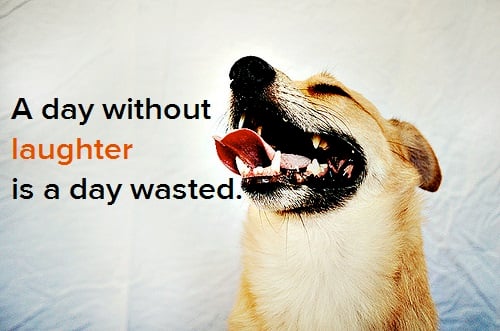
10 Brands Whose Visual Facebook Content Tickles Our Funny Bone
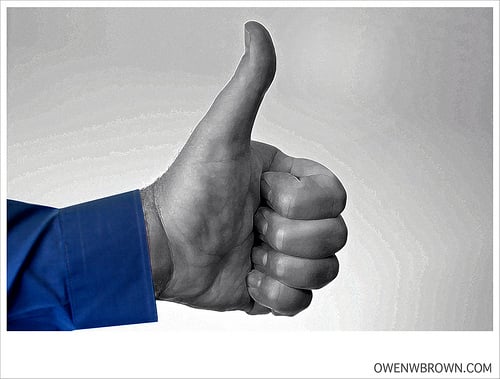
9 Excellent Examples of Brands Using Facebook's New Page Design
6 Facebook Marketing Best Practices
Facebook Fan Page Best Practices with Mari Smith [@InboundNow #18]
7 Awesome B2B Facebook Fan Pages
Learn how to maximize the value of your marketing and ad spend on Meta platforms Facebook and Instagram.
Marketing software that helps you drive revenue, save time and resources, and measure and optimize your investments — all on one easy-to-use platform

IMAGES
VIDEO
COMMENTS
See how businesses succeed in growing by using Facebook Custom Audiences. Read case studies about Facebook Custom Audiences.
The campaign engagement saw a 160x improvement over the industry average desktop advertising click-through rate (CTR). This campaign achieved a 3.3% CTR compared to the standard 0.02%, a 160x improvement. The 3.3% CTR also bested the typical social media CTR of 0.90% by 266%. Most importantly for the sales team, WSLS was able to increase the ...
ChicMe. The fashion brand ChicMe used Custom Audiences combined with some other Facebook advertising tools to connect with its target audience, driving an 82% lower cost per conversion, a 3.7X higher return on ad spend, 13% higher clickthrough rates, and 14% higher add-to-cart completion.
Luckily, Facebook has a guide on how to format your customer list to get the best matches. 2. Choose a Custom Audience Source. You'll be presented with a variety of options on where the source of your information comes from. Select "Customer list" and move on to the next step. 3. Import customer list.
Case Study # 5 - $14,114 in revenue from $8,240.17 spent in Facebook Ads. This case study is purely about generating leads than anything else. Brian Moran, the founder of SamCart, used Facebook As to sell his courses and training products. He tested three different targeting groups where; One group was his existing email list.
The campaign ran on Facebook and across Audience Network for a total of 5 weeks between March-April 2019, reaching Welk Resort website visitors based in the US. ... Custom audiences. Reach your customers and contacts on Facebook. Learn more. ... Case studies. Video. Events. Creative Hub. Skills and training. Online learning. Certification ...
Using Facebook custom audiences to promoting a service can also be effective. Evidence for this can be found in the AKBank case study. AKBank used custom audiences to target consumers who had already expressed an interest in taking out a loan. During their ad campaign, they saw, on average, over 500 conversions a day.
11 Facebook Case Studies & Success Stories to Inspire You. Pamela Bump. Published: August 05, 2019. Although Facebook is one of the older social media networks, it's still a thriving platform for businesses who want to boost brand awareness. With over 2.38 billion monthly active users, you can use the platform to spread the word about your ...
Learn how iOS 14 may affect your ad strategy. A custom audience is an ad targeting option that lets you find your existing audiences among people across Meta technologies. You can use sources such as customer lists, website or app traffic, or engagement across Meta technologies, to create custom audiences of people who already know your business.
You can create a custom audience from your website for any group of visitors that you'd like to reach with targeted ads. For example, you can run a campaign to reach people who visited a product page but didn't complete a purchase to encourage them to go back to the website to do so. Or, you can create an audience of everyone who's visited your ...
See how businesses succeed in growing by shopping Custom Audiences. Read case studies about shopping Custom Audiences.
A custom audience is an ad targeting option that lets you find your existing audiences among people across Meta technologies. You can use sources like customer lists, website or app traffic, or engagement across Meta technologies, to create custom audiences of people who already know your business. Learn more about the types of custom audiences ...
Engagement types. These are the types of engagement you can add to a rules section: Anyone who visited your Page. People who engaged with any post or ad. People who clicked with any call-to-action button. People who sent a message to your Page. People who saved your Page or any post.
A running list of ways brands use Klaviyo's Facebook integration. 1. To create a funnel that refills itself. 2. To promote the in-house brand to its biggest fans. 3. To show customers ultra-responsive lead-gen ads. 4. To create a lookalike audience seed for a women's apparel campaign.
An engagement custom audience is a custom audience made up of people who have engaged with your content across Meta technologies and services.. Engagement refers to actions people can take across Meta technologies such as viewing videos, following a Facebook Page or opening a form in a lead generation ad. Engagement custom audiences help you show your ads to people who've taken these actions.
When making a custom audience based on information customers have shared with you, include as much of it as possible to get the best match rates. This information - known as an "identifier" such as email, phone number, address - may come from customer lists you've prepared, or from Meta Pixel or offline events.
Use a custom or lookalike audience for targeting. Create an ad set. In the Advantage+ audience section of ad set creation, click Audience suggestion (optional). Click on the Custom audiences field and select the custom audiences and lookalike audiences you want to use. Note: You can combine multiple custom audiences and lookalike audiences to ...
Learn more about how European privacy directives may affect your ads and reporting. A custom audience made from a customer list is a type of audience that you can create to connect with people who have already shown an interest in your business or product. It's made of information - called "identifiers" - that you've collected about your ...
See how businesses succeed in growing by using the Facebook Audience Network. Read case studies about Audience Network.